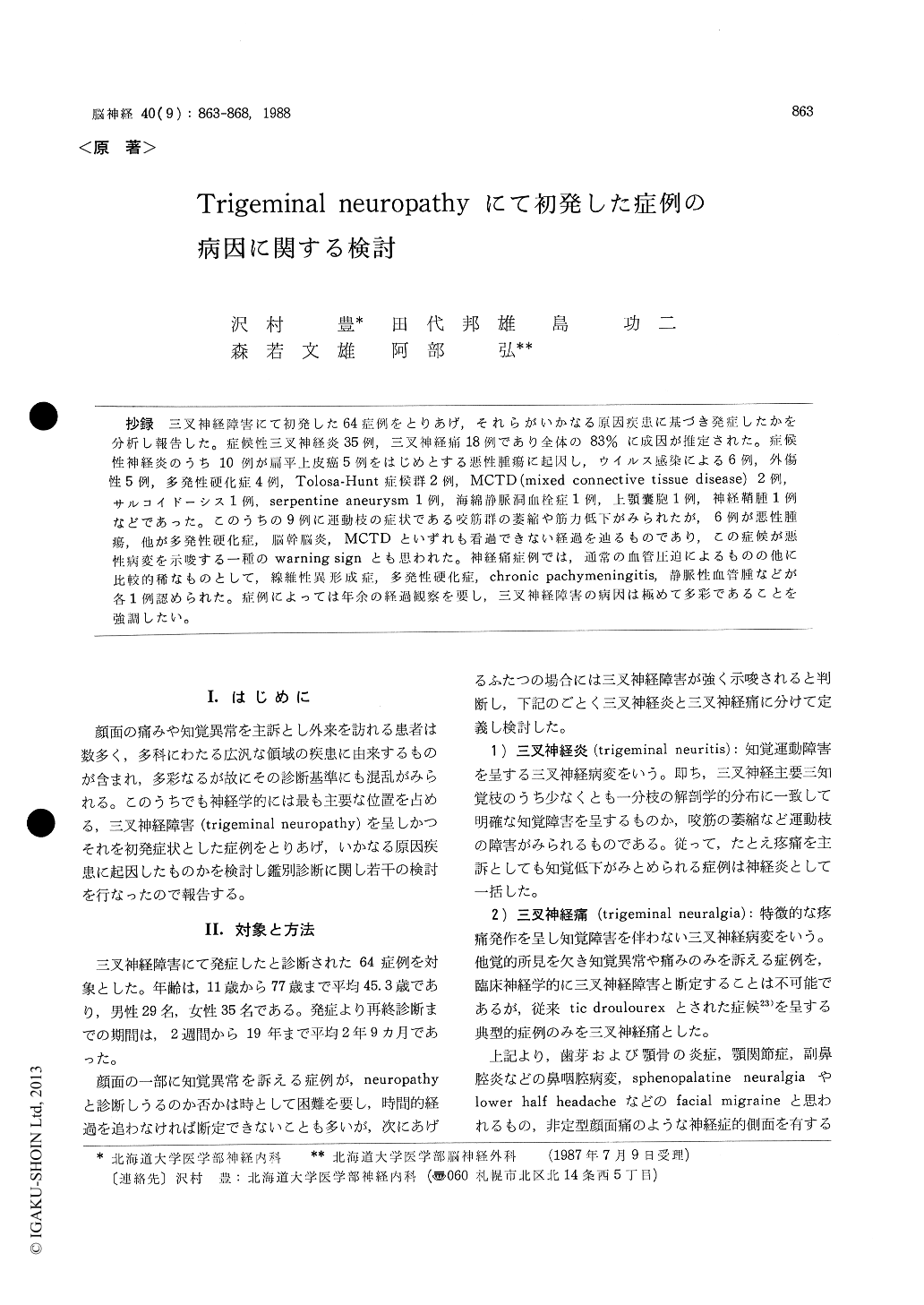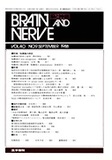Japanese
English
- 有料閲覧
- Abstract 文献概要
- 1ページ目 Look Inside
抄録 三叉神経障害にて初発した64症例をとりあげ,それらがいかなる原因疾患に基づき発症したかを分析し報告した。症候性三叉神経炎35例,三叉神経痛18例であり全体の83%に成因が推定された。症候性神経炎のうち10例が扁平上皮癌5例をはじめとする悪性腫瘍に起因し,ウイルス感染による6例,外傷性5例,多発性硬化症4例,Tolosa-Hunt症候群2例,MCTD (mixed connectlve tissue disease)2例,サルコイドーシス1例,serpentine aneurysm 1例,海綿静脈洞血栓症1例,上顎嚢胞1例,神経鞘腫1例などであった。このうちの9例に運動枝の症状である咬筋群の萎縮や筋力低下がみられたが,6例が悪性腫瘍,他が多発性硬化症,脳幹脳炎,MCTDといずれも看過できない経過を辿るものであり,この症候が悪性病変を示唆する一種のwarning signとも思われた。神経痛症例では,通常の血管圧迫によるものの他に比較的稀なものとして,線維性異形成症,多発性硬化症,chronic pachymeningitis,静脈性血管腫などが各1例認められた。症例によっては年余の経過観察を要し,三叉神経障害の病因は極めて多彩であることを強調したい。
The differential diagnosis of trigeminal neuro-pathy is quite challenging because there is a signi-ficant variety of causes for the disorder. We reviewed our cases of trigeminal neuropathy by studying first the initial manifestations in order to evaluate their underlying disorders.
Sixty-four patients with trigeminal neuropathy came to our Out-Patients clinic. We have excluded from our analysis any patients with atypical pain, facial migraine, nasal sinusitis, pain from inflama-tion of dental pulp or facial bones, and pre-trigemianl neuralgia. In 53 cases (83%) we identi-fied the causes ; 35 of them were cases of symp-tomatic trigeminal neuritis and 18 were trigeminal neuralgia while, in the remaining 11 cases, no definitive causative disorder was identified.
Among the 35 patients with symptomatic neu-ritis, 10 cases were found to have malignant neoplasms including 5 cases of squamous cell car-cinoma, 6 had a virus infection, 5 had traumatic origin, 4 had multiple sclerosis, 2 exhibited Tolosa-Hunt syndrome, 2 had MCTD, and there were single cases of sarcoidosis, serpentine aneurysm, cavernous sinus thrombosis, maxillay cyst and trigeminal neurinoma. The remaining 11 cases ofneuritis whose causes were undetermined showed clinical features similar to trigemianl sensory neuropathy, an analogue of Bell's palsy, a benign self-limiting condition. Since the cases shared symptoms of impairment of taste, and, occasionally, of facial palsy, vestibular insufficiency, hearing disturbance, hypoglossal palsy or signs of cerebel-lar lesion, we strongly suspected a virus origin.
Atrophy or weakness of the mastication muscles were found in 9 neuritis patients ; 6 of whom had malignant neoplasm, there was one case of multiple sclerosis, another of brainstem encephalitis and a third of MCTD. These facts suggest that the involvement of motor division in trigemianl neuritis should be considered as being a kind of warning sign of serious underlying diseases.
Although we categorized neuralgia narrowly, numerous complaints of facial pain were made by the neuritis patients. Since twenty-eight (61%)cases classified as having neuritis referred to their painful experience, they therefore had a form of neuralgia, rather than neuralgia in the strict sense of the term.
Of 18 patients who were suffering from typical neuralgia "Tic douloulex" not accompanied by any subjective or objective sensory and motor changes, 9 were classified as having idiopathic neuralgia that was or may have been due to neurovascular compression ; the remaining 9 cases were to have derived from such uncommon causes as trigeminal neurioma, middle fossa meningioma, chronic pa-chymeningtis, fibrous dysplasia, multiple sclerosis and old history of a trauma.
We would like to emphasize the importance of trigeminal nerve involvements, and the difficulty of studying them. They need to be examined and their progress followed with great care.

Copyright © 1988, Igaku-Shoin Ltd. All rights reserved.


